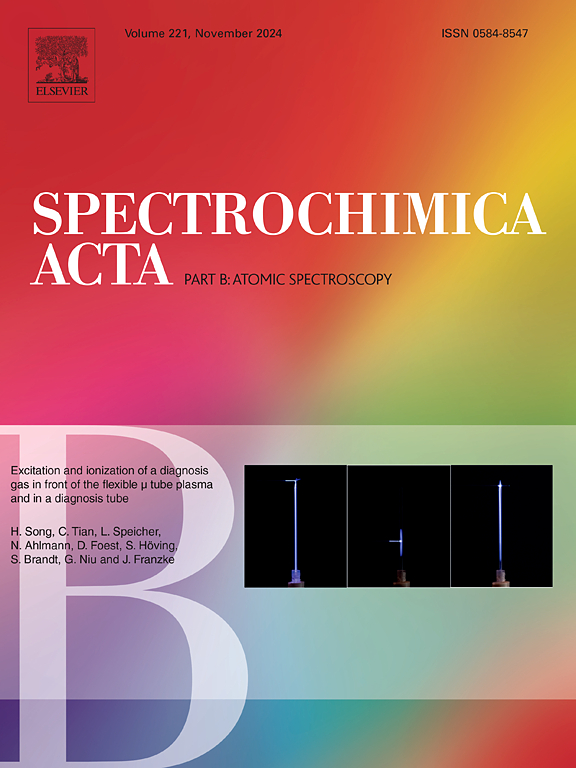Depth profiling the elemental composition with negative muons: Monte Carlo based tools for improved data analysis
IF 3.8
2区 化学
Q1 SPECTROSCOPY
引用次数: 0
Abstract
Gildings, patinas and alteration crusts are common features of many heritage artefacts, especially for metals. Their size depends on many factors, like the manufacturing method for gildings or the conservation state for alteration crusts: in some cases, it can be in the scale of the tens of microns. Such thickness would be difficult to investigate with classical non-destructive methods and would prevent getting information from the bulk of the sample. This work proposes an innovative approach for the study of multi-layered materials with the Muonic atom X-ray Emission Spectroscopy technique (μ-XES). Based on the detection of the high-energy X-rays emitted after the muon capture by the atom, this method is characterised by a remarkable penetration depth (from microns to cm). From the surface to the bulk, this technique can evaluate the variation of the elemental composition as a function of depth. The paper focuses on providing an improved interpretation of μ-XES data by coupling the analysis with the use of two Monte Carlo simulation software, GEANT4/ARBY and SRIM/TRIM. With these two software, it is possible to replicate the negative muon experiments and compare the experimental and simulated outputs to address the size of a given layer. To validate this approach, a set of standard gilded bronze and brass foils were measured at the ISIS Neutron and Muon source. From simulations, it was possible to evaluate the thickness of the superficial gold layer, with results in agreement with the preliminary SEM characterisation of the samples.

用负介子深度剖析元素组成:基于蒙特卡罗的改进数据分析工具
镀金、铜绿和蚀变结壳是许多文物,特别是金属文物的共同特征。它们的大小取决于许多因素,比如镀金的制造方法或蚀变结壳的保存状态:在某些情况下,它可以在几十微米的尺度上。这样的厚度很难用经典的非破坏性方法来研究,并且会阻止从大部分样品中获得信息。本工作提出了一种利用μ- x射线发射光谱技术研究多层材料的创新方法。基于对原子捕获μ子后发射的高能x射线的探测,这种方法的特点是具有显著的穿透深度(从微米到厘米)。从表面到体块,该技术可以评估元素组成随深度的变化。本文将μ- x数据与两个蒙特卡罗仿真软件GEANT4/ARBY和SRIM/TRIM相结合,对μ- x数据进行了改进的解释。使用这两个软件,可以复制负μ子实验,并比较实验和模拟输出,以解决给定层的大小。为了验证这种方法,在ISIS中子和介子源上测量了一组标准镀金青铜和黄铜箔。从模拟中,可以评估表面金层的厚度,结果与样品的初步SEM表征一致。
本文章由计算机程序翻译,如有差异,请以英文原文为准。
求助全文
约1分钟内获得全文
求助全文
来源期刊
CiteScore
6.10
自引率
12.10%
发文量
173
审稿时长
81 days
期刊介绍:
Spectrochimica Acta Part B: Atomic Spectroscopy, is intended for the rapid publication of both original work and reviews in the following fields:
Atomic Emission (AES), Atomic Absorption (AAS) and Atomic Fluorescence (AFS) spectroscopy;
Mass Spectrometry (MS) for inorganic analysis covering Spark Source (SS-MS), Inductively Coupled Plasma (ICP-MS), Glow Discharge (GD-MS), and Secondary Ion Mass Spectrometry (SIMS).
Laser induced atomic spectroscopy for inorganic analysis, including non-linear optical laser spectroscopy, covering Laser Enhanced Ionization (LEI), Laser Induced Fluorescence (LIF), Resonance Ionization Spectroscopy (RIS) and Resonance Ionization Mass Spectrometry (RIMS); Laser Induced Breakdown Spectroscopy (LIBS); Cavity Ringdown Spectroscopy (CRDS), Laser Ablation Inductively Coupled Plasma Atomic Emission Spectroscopy (LA-ICP-AES) and Laser Ablation Inductively Coupled Plasma Mass Spectrometry (LA-ICP-MS).
X-ray spectrometry, X-ray Optics and Microanalysis, including X-ray fluorescence spectrometry (XRF) and related techniques, in particular Total-reflection X-ray Fluorescence Spectrometry (TXRF), and Synchrotron Radiation-excited Total reflection XRF (SR-TXRF).
Manuscripts dealing with (i) fundamentals, (ii) methodology development, (iii)instrumentation, and (iv) applications, can be submitted for publication.

 求助内容:
求助内容: 应助结果提醒方式:
应助结果提醒方式:


